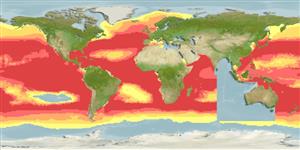Actinopterygii (ray-finned fishes) >
Perciformes (Perch-likes) >
Echeneidae (Remoras)
Etymology: Remora: Latin, remora = delay, hindrance (1567) (Ref. 45335).
Environment / Climate / Range
Ecology
Marine; pelagic-oceanic; oceanodromous (Ref. 51243). Subtropical, preferred ?
Worldwide in warm seas. Western Atlantic: Nova Scotia, Canada to Brazil. Eastern Central Atlantic: Madeira Island (Ref. 74541).
Size / Weight / Age
Maturity: Lm ? range ? - ? cm
Max length : 50.0 cm TL male/unsexed; (Ref. 55763); common length : 25.0 cm TL male/unsexed; (Ref. 55763)
Dorsal
spines
(total): 0;
Dorsal
soft rays
(total): 27-34;
Anal
spines: 0;
Anal
soft rays: 25 - 34. Body cylindrical and elongate; possessing an oblong cephalic disk with 14 to 17 transverse laminae; cranium depressed (supporting cephalic disk); dorsal fin with 27 to 44 rays; first gill arch with fewer than 21 gill rakers; body entirely white to pale blue (Ref. 55763).
Found on the body and inside gill chamber of billfishes and swordfishes, rarely on any other fishes (Ref. 2850); also in the gill cavities and mouths of sharks (Ref. 5951).
Life cycle and mating behavior
Maturity | Reproduction | Spawning | Eggs | Fecundity | Larvae
Paxton, J.R., D.F. Hoese, G.R. Allen and J.E. Hanley, 1989. Pisces. Petromyzontidae to Carangidae. Zoological Catalogue of Australia, Vol. 7. Australian Government Publishing Service, Canberra, 665 p. (Ref. 7300)
IUCN Red List Status (Ref. 115185)
CITES (Ref. 94142)
Not Evaluated
Threat to humans
Harmless
Human uses
More information
Common namesSynonymsMetabolismPredatorsEcotoxicologyReproductionMaturitySpawningFecundityEggsEgg development
ReferencesAquacultureAquaculture profileStrainsGeneticsAllele frequenciesHeritabilityDiseasesProcessingMass conversion
Tools
Special reports
Download XML
Internet sources
